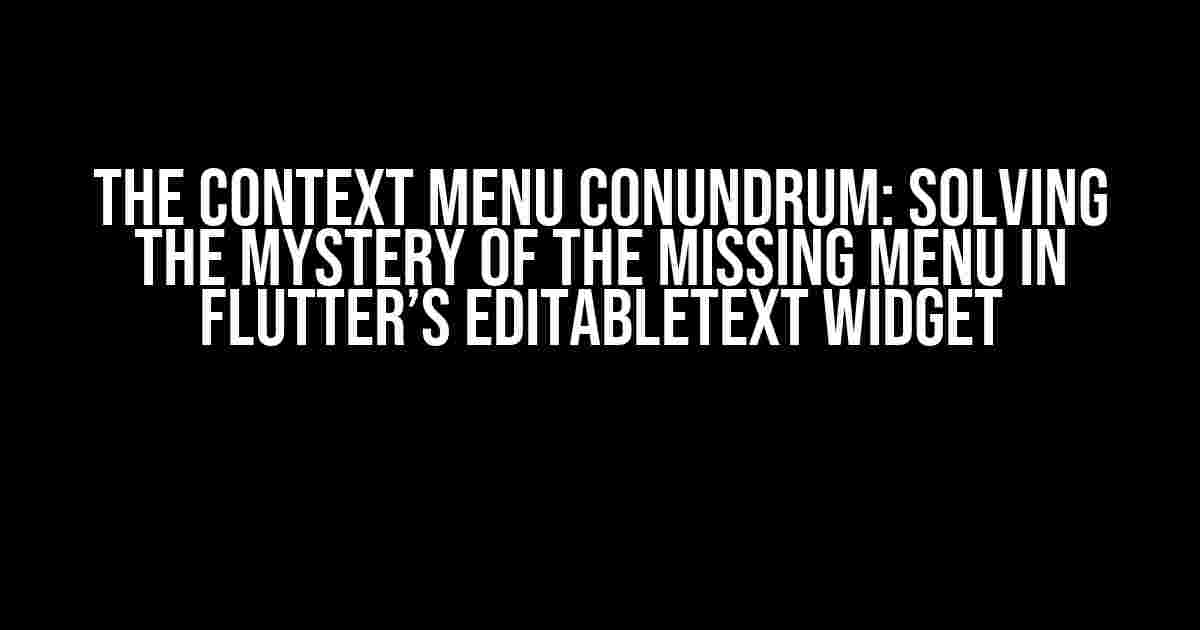Are you frustrated by the elusive context menu in Flutter’s EditableText widget? You’re not alone! Many a developer has scratched their head, wondering why the context menu refused to make an appearance. Fear not, dear reader, for we’re about to embark on a thrilling adventure to uncover the secrets behind this enigmatic issue.
The Problem Statement
The EditableText widget is a powerful tool in Flutter, allowing users to edit text with ease. However, when attempting to display a context menu, many developers are left staring at a blank screen. The context menu, which typically appears when long-pressing or right-clicking on the text, is nowhere to be found. It’s as if it has vanished into thin air, leaving behind a trail of confusion and frustration.
Why Does This Happen?
There are several reasons why the context menu might not be showing up when using the EditableText widget in Flutter. Let’s explore some of the most common culprits:
- Incorrect Widget Hierarchy: If the EditableText widget is not properly wrapped within a widget that supports the context menu, it will not appear.
- Missing Gesture Recognizers: The EditableText widget relies on gesture recognizers to detect long-presses and right-clicks. Without these recognizers, the context menu will not be triggered.
- Overriding the Default Behavior: If you’ve overridden the default behavior of the EditableText widget, you might be inadvertently suppressing the context menu.
Solving the Mystery: Step-by-Step Guide
Now that we’ve identified the potential culprits, let’s dive into a step-by-step guide to resolving the issue:
Step 1: Verify the Widget Hierarchy
Ensure that your EditableText widget is properly wrapped within a widget that supports the context menu. A commonly used widget for this purpose is the GestureDetector. Here’s an example:
GestureDetector(
child: EditableText(
// Your EditableText configuration here
),
onLongPress: () {
// Handle long press event
},
onSecondaryTap: () {
// Handle secondary tap (right-click) event
},
)
Step 2: Add Gesture Recognizers
Make sure to add the necessary gesture recognizers to your EditableText widget. You can do this by wrapping the widget with a RawGestureDetector and specifying the required recognizers:
RawGestureDetector(
gestures: {
LongPressGestureRecognizer: GestureRecognizerFactoryWithHandlers(
() => LongPressGestureRecognizer(),
(LongPressGestureRecognizer instance) {
instance.onLongPress = () {
// Handle long press event
};
},
),
SecondaryTapGestureRecognizer: GestureRecognizerFactoryWithHandlers(
() => SecondaryTapGestureRecognizer(),
(SecondaryTapGestureRecognizer instance) {
instance.onSecondaryTap = () {
// Handle secondary tap (right-click) event
};
},
),
},
child: EditableText(
// Your EditableText configuration here
),
)
Step 3: Avoid Overriding Default Behavior
Be cautious when overriding the default behavior of the EditableText widget. Make sure you’re not inadvertently suppressing the context menu. If you need to customize the widget’s behavior, try to do so in a way that doesn’t interfere with the context menu.
Additional Troubleshooting Tips
If the above steps don’t resolve the issue, here are some additional tips to help you troubleshoot:
- Check for Platform-Specific Issues: Ensure that the issue is not platform-specific. Try running your app on different devices and platforms to isolate the problem.
- Verify Widget Focus: Make sure the EditableText widget has focus when you’re attempting to display the context menu. You can use the
FocusNodeto manage focus. - Test with Different Gestures: Try triggering the context menu with different gestures, such as long-pressing or right-clicking, to ensure the issue is not specific to a particular gesture.
Conclusion
The context menu conundrum in Flutter’s EditableText widget can be a frustrating experience, but fear not! By following the steps outlined in this article, you should be able to resolve the issue and restore the context menu to its former glory. Remember to verify your widget hierarchy, add the necessary gesture recognizers, and avoid overriding default behavior. With these tips and a healthy dose of patience, you’ll be well on your way to solving the mystery of the missing context menu.
| Troubleshooting Tip | Description |
|---|---|
| Check Widget Hierarchy | Ensure the EditableText widget is properly wrapped within a widget that supports the context menu. |
| Add Gesture Recognizers | Use RawGestureDetector to add necessary gesture recognizers to the EditableText widget. |
| Avoid Overriding Default Behavior | Be cautious when customizing the EditableText widget’s behavior to avoid suppressing the context menu. |
| Check for Platform-Specific Issues | Verify the issue is not platform-specific by testing on different devices and platforms. |
| Verify Widget Focus | Ensure the EditableText widget has focus when attempting to display the context menu. |
| Test with Different Gestures | Try triggering the context menu with different gestures to isolate the problem. |
By following these guidelines and troubleshooting tips, you’ll be well-equipped to tackle the context menu conundrum in Flutter’s EditableText widget. Happy coding!
Bonus: Advanced Context Menu Customization
Once you’ve resolved the issue of the missing context menu, you might want to explore advanced customization options to make your app stand out. Here are some ideas to get you started:
- Custom Context Menu Items: Create custom context menu items that cater to your app’s specific needs.
- Context Menu Styling: Customize the appearance and feel of the context menu to match your app’s branding.
- Dynamic Context Menu Items: Dynamically generate context menu items based on user input or app state.
With the power of Flutter’s EditableText widget and a deep understanding of context menu customization, the possibilities are endless! Don’t be afraid to experiment and push the boundaries of what’s possible.
Here are 5 Questions and Answers about “The context menu is not showing when using EditableText widget in Flutter”:
Frequently Asked Question
Got stuck while working with EditableText widget in Flutter? Don’t worry, we’ve got you covered!
Why is the context menu not showing up when I long press on the EditableText widget in Flutter?
This issue might occur if you haven’t enabled the `contextMenu` property of the EditableText widget. You need to set it to `true` to display the context menu. For example: `EditableText(contextMenu: true, …)`. Give it a try!
I’ve set `contextMenu` to `true`, but the menu still doesn’t appear. What’s going on?
Make sure you’re not using `AbsorbPointer` or `IgnorePointer` widgets as parents of the EditableText widget. These widgets can absorb or ignore the long press event, preventing the context menu from showing up. Try removing them or rearranging your widget tree.
How can I customize the context menu items for my EditableText widget?
You can use the `contextMenuBuilder` property of the EditableText widget to customize the menu items. This property takes a callback function that returns a list of `ContextMenuButtonItem`s. For example: `EditableText(contextMenuBuilder: (context) => [ContextMenuButtonItem(label: ‘Custom Item’, onPressed: () { print(‘Custom item pressed’); })], …)`. Get creative with your menu items!
Can I disable the default context menu items for my EditableText widget?
Yes, you can! Set the `contextMenu` property to a custom `ContextMenu` object with an empty list of items. For example: `EditableText(contextMenu: ContextMenu(items: []), …)`. This will disable the default menu items, and you can add your own custom items using the `contextMenuBuilder` property.
Why does the context menu still show up even when my EditableText widget is not focusable?
By default, the context menu will still show up even when the EditableText widget is not focusable. If you want to disable the context menu when the widget is not focusable, you can use the `contextMenu` property and check the `focusNode.hasFocus` property before showing the menu. For example: `EditableText(contextMenu: focusNode.hasFocus ? ContextMenu(items: […]) : null, …)`. Give it a try!


